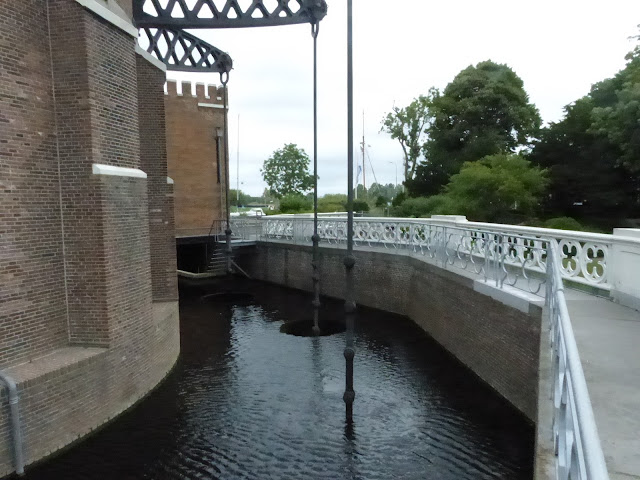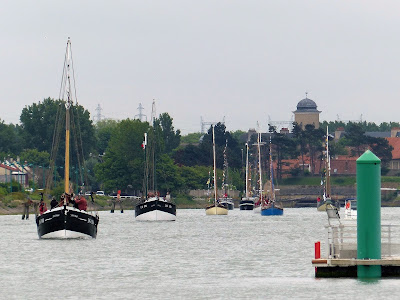Sunday 25th
June – to Haarlem – 11.6nm
We're
following what is known as the Staande Mastroute, or mast-up route,
north through the Netherlands. To guide us we have an excellent
publication from the ANWB, unfortunately in a now rather out-of-date
edition. The charts are usable although some new bridges have been
built since our 2009 edition was published. Goudaaksebrug just south
of Gouda wasn't in our book and nor was the Amaliabrug just to the
north. Some bridges have new names just to confuse us (such as the
Kaagbrug where we spent last night, which used to be called the
Sassenheim) and the timetables for the bridge openings are
often out of date too. It's been updated once in pencil (when we used
it in 2014) and now we're using it in conjunction with a pdf file of
up-to-date bridge timetables on Howard's mobile phone. Laborious but
it seems to be working.
 |
The mast-up route(s) across the Netherlands.
We didn't do pages 4 or 5 but came in to Dordrecht from the west at the very top of page5.
Pages 6 and 7 got us to Gouda, on page 9 we forked left at Alphen then turned left to go to Haarlem via pages 18 and 19.
The route via pages 10 and 11 involves a night convoy through the middle of Amsterdam which we have always avoided. |
 |
| Here's page 19 |
The blue
boxes show yacht harbours and clubs suitable for stopovers and the
red boxes are bridge timetables. Beware the asterisks! One year here
we fell foul of well hidden messages such as “unless the river is
NAP + 2m” or “but only on the hour for leisure craft” or, very
sneaky, “for commercial traffic only but if opened leisure craft
may also pass”. We have learnt to persevere with Google Translate on
the small print – although Google struggles with NAP too. We knew
the A was for Amsterdam and that it's about water levels but for the
purposes of educating ourselves (and now you) we have found out from
Wikipedia that it stands for Normaal Amsterdams Peil. This converts to English as Amsterdam Ordnance Datum, though I'd translate it as Normal Amsterdam Level.
It's not just sea levels they have to worry about here, it's all the
fresh water coming down the Rhine as well but they do seem to have
that under control so far on this trip.
In the
approach to Haarlem there is a museum on the theme of the constant battle the Dutch have with water. On previous trips we have hurried
past on our way to the bright lights. Today we stopped to see what we'd been missing.
 |
| Cruquius Museum, very gothic in style, is a Victorian pumping station which, together with 3 others like it, pumped dry an enormous lake to reclaim the land. The figures on volumes and time frames are impressive. The building houses the world's largest steam engine - the main cylinder measures 3.66m across. The boilers are long gone now but we saw a demonstration of it in action powered by modern hydraulics |
 |
| The pump was steam-driven and had six enormous boilers like this - all were scrapped when the pumping station was decommissioned in the 1930s - this is just the front end of one similar which was found in a scrap yard |
 |
| That cylinder is 3.66m wide - cast in Cornwall |
 |
| Up go the tops of the 8 arms lowering huge buckets outside which will lift the water 9m to the level of the river where it will run off |
 |
| View upwards |
 |
| Each of the 8 huge arms has a bucket which lifted 8 tons of water, five times a minute, from the level of the lake 9m below to here where it will flow off into the river Spaarn. All 8 buckets came up at once so the engine was lifting 64 tons each time. That makes 320 tons of water per minute. Behind you can just see Bonify's mast where she's tied up in the river. |
 |
| Steel flaps form the bottom of the bucket: they "feather" as the cylinder is lowered through the water, then the force of the water in the cylinder closes them across at the bottom to from the base of the bucket as it is lifted. Technically Howard says you'd describe this as a non-return valve. Hope you are keeping up! |
 |
| As you might expect there are steam engines for sale here - several different models. Howard was pleased to find one very similar to the one he used to have (sadly lost in our workshop fire in 2009) |













Lovely, as always, reading your blog. So interesting and informative and great to keep track of your progress. Especially liked this one about the pumping station - knew about that from the Prunella Scales and Timothy West programme when they sailed the Dutch waterways.
ReplyDelete